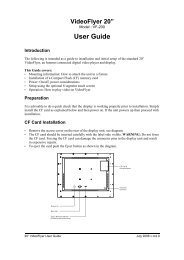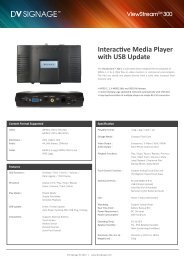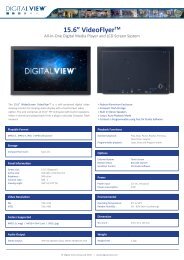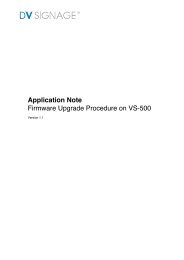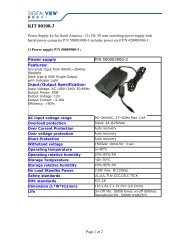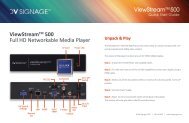Content Creation Guide Introduction to Encoding - DV Signage
Content Creation Guide Introduction to Encoding - DV Signage
Content Creation Guide Introduction to Encoding - DV Signage
You also want an ePaper? Increase the reach of your titles
YUMPU automatically turns print PDFs into web optimized ePapers that Google loves.
Bit Rate: 2 Mbit/s<br />
Audio Bit Rate: 224 Kbit/s, 48 kHz at 16 bits sample rate<br />
Frame Rate: PAL: 25 Hz / NTSC: 29.97 Hz<br />
Codec: MPEG-4 DivX 5.2 or higher<br />
Typical filename extension: .avi<br />
Note: Depending on the features desired, cus<strong>to</strong>mer/purchaser may be required <strong>to</strong> apply and obtain a video<br />
codec license with the respective organizations.<br />
CF Card Use<br />
HD resolutions (e.g. 1080p) require higher transfer rates. It is recommended <strong>to</strong> use newer,<br />
high-speed CF cards. 100x, 15Mb/s cards have been found <strong>to</strong> be suitable in tests.<br />
3.3 Codec Recommendations<br />
Our recommendations:<br />
<br />
<br />
<br />
<br />
<br />
<br />
H.264 / AVC: The newest and most efficient in terms of file size for quality, also it is<br />
the mainstream trend. For media players where this is available it is the<br />
recommended codec.<br />
DivX: Quality and file sizes are good (small) but it is a proprietary codec.<br />
WMV: Quality and file sizes are good but it seems <strong>to</strong> be primarily a Microsoft<br />
Windows PC standard.<br />
MPEG-4: Quality and file sizes are good. MPEG-4 is the underlying technology for<br />
WMV, DivX and H.264/AVC.<br />
MPEG-2: Quality is good but file sizes are considerably larger than the MPEG-4<br />
related codec‟s.<br />
MPEG-1: Resolution is low and file sizes are relatively inefficient for the quality,<br />
generally not recommended if a better quality alternative, ie one of the above, is<br />
available.<br />
For more information about the various codec‟s see the appendix<br />
3.4 Some General Principles<br />
In general the following is important:<br />
<br />
<br />
<br />
<br />
Quality of the original material: It is a cliché but „garbage in, garbage out‟. MPEG<br />
decoders and the display circuitry will do what it can <strong>to</strong> improve the quality of the<br />
picture but if the original material is of poor quality the result is likely <strong>to</strong> be poor or<br />
worse.<br />
Resolution of the input and the output: In general higher resolution will be better<br />
but this may be one of the key compromises made in a system and display choice. If<br />
a low resolution video standard such as PAL/NTSC is being used or the display is low<br />
resolution then content needs <strong>to</strong> be designed accordingly and fine details such as<br />
small text should be avoided.<br />
Choice of codec and data rate: MPEG-4 related codec‟s generally provide the<br />
optimal mix between quality and data-rate. This benefit increases with higher<br />
resolution video.<br />
Transcoding: All these codec‟s are lossy and therefore repeated transcoding will<br />
result in generational quality loss. This is most apparent when the resolution and bitrate<br />
are equivalent. Transcoding <strong>to</strong> a lower resolution or bit-rate will minimize<br />
noticeable transcoding quality loss.<br />
© Digital View Ltd 2009 <strong>Content</strong> <strong>Creation</strong> <strong>Guide</strong> Page 10 of 21







